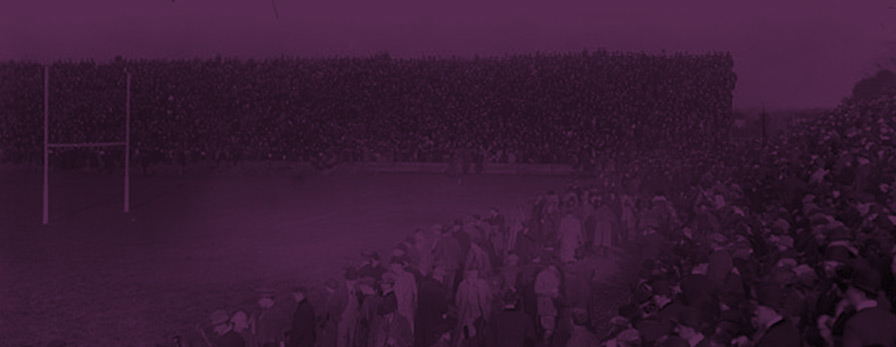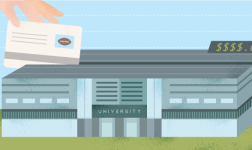By: Chad McEvoy and Nels Popp
Background
Revenue generation is of paramount importance to Division I athletic administrators today, particularly in the external function areas of the athletic department. The need to generate revenue has become even more heightened in recent years due to a combination of increased tuition and scholarship costs, the recent economic recession, and the importance of keeping up with competing schools. According to research conducted by Dan Fulks, NCAA Division I athletic departments generate a significant percentage of their department revenue from ticket sales. Fulks’ research found during the 2008-2009 academic year, 28% of the generated revenues of Football Bowl Subdivision (FBS) schools came from ticket sales, considerably more than other individual revenue sources such as media contracts, donations, sponsorships, and game guarantees.
Despite the importance of revenue generation and specifically ticket revenue, college athletic programs have been much slower to implement outbound sales teams in a similar fashion to professional sports teams. Just five years ago, no more than a dozen such outbound sales efforts could be found in all of Division I athletics. We have seen explosive growth in this area in the past couple years however, and now estimate more than 100 Division I schools have implemented outbound sales teams, with seemingly new additions to this list made every month.
Purpose
In following closely this trend of outbound sales growth in college athletics, we conducted an exploratory research project in the summer and fall of 2011. Our primary purposes were to examine the scope and structure of Division I outbound sales programs, as well as to assess their effectiveness. Regarding effectiveness, we attempted to answer the question from an athletic director’s perspective of how will adding an outbound ticket sales force impact ticket revenues.
Scope and Structure of Outbound Sales Efforts
In the summer of 2011, we electronically surveyed sales directors, marketing personnel, or ticket operations staff at all 347 NCAA division I institutions to determine trends in on-campus outbound ticket sales efforts. After sending multiple follow-ups to non-respondents, a total of 137 schools responded to the survey, for a rate of 39.5%. Among respondents, 84 (61.3%) indicated at least one member of their athletic department staff was currently making outbound ticket sales calls. After reviewing the websites of all non-respondents, it appears this number is likely skewed towards athletic departments which have instituted a sales program. This is unsurprising as those with a sales program likely had more of a vested interest in this research topic and would therefore be more prone to complete the survey.
The bigger question is: what constitutes a sales team? While over 60% of respondents reported staff members making outbound sales calls, 72% of those athletic departments reported assigning two or fewer full-time staff members to the job of making sales calls (see table below). By comparison, most major league professional sports teams have sales staffs ranging from 30 to 70 employees. Further, many major league teams encourage their sales reps to make 70 to 100 outbound calls per day. When college athletics personnel were asked how many calls their sales teams made per week, the mean was 655. However, the range of responses spanned from a high of 3,500 to a low of 3. In fact, 30% of respondents said their sales teams make fewer than 100 outbound calls per week.
Staff Composition Among Respondent Schools Possessing an Outbound Ticket Sales Program
| Number of Sales Staff Per Category | Full-Time | Graduate Assistants | Part-Time | Undergraduate Students |
| None | 16.4% | 80.6% | 76.1% | 37.3% |
| 1 to 2 | 55.2% | 17.9% | 13.4% | 29.9% |
| 3 to 4 | 23.9% | 1.5% | 7.7% | 19.4% |
| 5 or more | 4.5% | 0.0% | 3.0% | 13.4% |
The small sizes of collegiate outbound sales staffs and the school-to-school variability in size and scope is not surprising as many of the sales programs are in their infancy while just a few have developed more rapidly. As outbound sales staffs establish themselves on campuses and have success in generating increased ticket sales revenues, we’re likely to see them grow and develop in staff size, call volume, and emphasis on training. We also anticipate continued rapid growth in the number of Division I schools creating new outbound sales staffs, including a mix of in-house sales operations and those that are outsourced to companies such as IMG Learfield Ticket Operations and The Aspire Group. The number of collegiate sales teams has expanded from just a handful to more than one hundred in the past five years and we expect to see the vast majority of Division I schools develop some type of outbound sales programs over the next several years.
Impact of Outbound Sales Efforts on Ticket Revenue
Perhaps of greater concern than the structure of these sales teams is their effectiveness. Does the income generated by a sales team not only off-set the setup costs, but actually create significant new ticket revenue for the department? Anecdotal evidence would suggest that it does. Matt DiFebo’s sales force generated over $4.5 million in his first year working with the football program at the University of Central Florida in 2006. Bill Fagan and the Aspire Group helped the athletic department realize $1.2 million in new ticket revenue for football and men’s basketball in a single season at Georgia Tech. Temple University increased football revenue by 42 percent per game after hiring DiFebo as a consultant. However, no research has examined this issue from a more comprehensive perspective to determine if similar results can be expected from any school which initiates an outbound sales force, or if the aforementioned examples are anomalies.
Ticket revenue data was available for some of the schools reporting their sales practices allowing for more sophisticated analysis. Of schools which reported adding an outbound sales program, 26 had accessible ticket revenue data, allowing us to compare ticket revenues from their first years with an outbound sales program to the last year without. On average, those 26 schools saw an increase of 15.4 percent in their ticket revenues during the first year of outbound ticket sales, for a mean ticket revenue increase of almost exactly $1 million. Among all NCAA Division I schools over a similar time frame, the average annual increase in ticket sales was just 2.5 percent, demonstrating a remarkable return on investment for schools starting new outbound sales programs.
In taking the analysis a step further, we examined these 26 new outbound sales programs to see whether some were more successful than others and, if so, what factors might relate to that degree of success. A considerable spread in ticket revenues was discovered among the new outbound sales programs, ranging from a 323 percent increase to a 20 percent decrease. Eight of the 26 schools realized a decrease in sales revenues in the first year of outbound sales, which isn’t surprising given the impact of other factors such as on-field performance of high-profile teams. We found a natural point of delineation where 12 of the schools generated ticket revenue increases of greater than 19 percent while the other 14 subject schools saw increases of 11 percent or less (again with eight of those having ticket revenue decreases), and examined differences between these two groups, as highlighted in the table below.
Comparing Highly Successful and Less Successful Outbound Ticket Sales Programs
|
Criteria |
Highly Successful Outbound Programs | Less Successful Outbound Programs |
| Average ticket revenue increase in Year One | 32.23% | 2.18% |
| Number of full time sales staff | 2.42 | 1.62 |
| Number of total sales staff | 9.42 | 5.08 |
| Number of staff full-time equivalency | 4.40 | 2.77 |
| Number of outbound calls per week | 806.11 | 497.00 |
As the table shows, clear distinctions can be seen between two groups of new outbound sales programs. In the highly successful group, programs included 2.4 full-time sales staff members, 9.4 total sales staff members, and 806 calls made per week, resulting in an average increase in ticket revenues of an astounding 32.2 percent. In those sales programs that did not have as much initial success, the department employed 1.6 full-time sales staff members, 5.1 total sales staff members, and made an average of 497 outbound calls per week. These schools realized an average ticket revenue increase of just 2.2%. The highly successful group also reported investing more time and frequency in formal sales training.
Our conclusion from this examination is that while most schools will generate significant return on investment from adding an outbound sales program to the external operations of their athletic department (again, the average increase of all schools examined was 15.4 percent in one year), those that invested more extensively were rewarded accordingly. Athletic departments willing to make substantial investments in their outbound sales teams, including staffing, training, and call volume, have the opportunity to realize vast gains in ticket revenues. In the current economic climate and with other revenue streams seemingly near their peak potential, we expect to see many more athletic departments pursuing outbound ticket sales.
——————————————-
We give special thanks to Dr. Chad McEvoy and Dr. Nels Popp.
 Dr. Chad McEvoy, formerly of Illinois State University, begins this summer as a professor in the David B. Falk College of Sport and Human Dynamics at Syracuse University.
Dr. Chad McEvoy, formerly of Illinois State University, begins this summer as a professor in the David B. Falk College of Sport and Human Dynamics at Syracuse University.
 Dr. Nels Popp is an assistant professor and coordinator of the sport management program at Illinois State University. The authors are currently conducting further research on outbound ticket sales in collegiate athletics and welcome discussion.
Dr. Nels Popp is an assistant professor and coordinator of the sport management program at Illinois State University. The authors are currently conducting further research on outbound ticket sales in collegiate athletics and welcome discussion.




